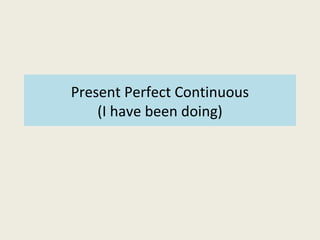Present Perfect Continuous
•Download as PPT, PDF•
0 likes•406 views
Grammar
Report
Share
Report
Share

Recommended
Project finished and unfinished actions. present perfect and present perfect continuous.C15 U2 Project finished and unfinished actions. present perfect and present...

C15 U2 Project finished and unfinished actions. present perfect and present...colomboamericanopereira
Recommended
Project finished and unfinished actions. present perfect and present perfect continuous.C15 U2 Project finished and unfinished actions. present perfect and present...

C15 U2 Project finished and unfinished actions. present perfect and present...colomboamericanopereira
More Related Content
What's hot
What's hot (20)
Presentsimple vs presentcontinuous por Monica Saenz

Presentsimple vs presentcontinuous por Monica Saenz
Similar to Present Perfect Continuous
Similar to Present Perfect Continuous (20)
Present perfect continuous / present perfect progressive 

Present perfect continuous / present perfect progressive
More from MariaKarlaSepcon
More from MariaKarlaSepcon (20)
Alphabets. Vowels. Consonants. Small Letters. Capital Letters

Alphabets. Vowels. Consonants. Small Letters. Capital Letters
Recently uploaded
https://app.box.com/s/7hlvjxjalkrik7fb082xx3jk7xd7liz3TỔNG ÔN TẬP THI VÀO LỚP 10 MÔN TIẾNG ANH NĂM HỌC 2023 - 2024 CÓ ĐÁP ÁN (NGỮ Â...

TỔNG ÔN TẬP THI VÀO LỚP 10 MÔN TIẾNG ANH NĂM HỌC 2023 - 2024 CÓ ĐÁP ÁN (NGỮ Â...Nguyen Thanh Tu Collection
Recently uploaded (20)
TỔNG ÔN TẬP THI VÀO LỚP 10 MÔN TIẾNG ANH NĂM HỌC 2023 - 2024 CÓ ĐÁP ÁN (NGỮ Â...

TỔNG ÔN TẬP THI VÀO LỚP 10 MÔN TIẾNG ANH NĂM HỌC 2023 - 2024 CÓ ĐÁP ÁN (NGỮ Â...
QUATER-1-PE-HEALTH-LC2- this is just a sample of unpacked lesson

QUATER-1-PE-HEALTH-LC2- this is just a sample of unpacked lesson
Unit 3 Emotional Intelligence and Spiritual Intelligence.pdf

Unit 3 Emotional Intelligence and Spiritual Intelligence.pdf
Play hard learn harder: The Serious Business of Play

Play hard learn harder: The Serious Business of Play
Sensory_Experience_and_Emotional_Resonance_in_Gabriel_Okaras_The_Piano_and_Th...

Sensory_Experience_and_Emotional_Resonance_in_Gabriel_Okaras_The_Piano_and_Th...
Present Perfect Continuous
- 1. Present Perfect Continuous (I have been doing)
- 2. Have/has been -ing • Have/has been –ing is the present perfect continuous: I/we/they/you have (= I’ve, etc.) been doing, waiting, playing, etc.he/she/it has (= he’s, etc.)
- 3. Present perfect continuous • The present continuous describes what a person is doing. • The present perfect continuous tells how long a person has been doing that action. Ex. Katie is delivering mail. She has been delivering mail for two hours. she has been working for the post office since 1997.
- 4. Present perfect continuous • The present perfect continuous talks about an action that started in the past and continues in the present. The action is not yet complete. It tells how long the action has been in progress.
- 5. He has been washing windows since 8:00. They have been waiting for the bus for twenty minutes.
- 6. Present perfect continuous I You We They have been working since 8:00. for two hours.He She It has
- 7. Since & For You can use the present perfect continuous for actions that are repeated over a period of time: • Debbie is a very good tennis player. She’s been playing since she was eight. • Every morning they meet in the same café. They’ve been going there for years.
- 8. For and since • For shows an amount of time. for three hours for ten days • Since tells when an action started since 2:00 since he came to the United States
- 9. For and since For Since For shows an amount of time: Since tells when an action started: for a few minutes since 2:00 for three weeks since 1998 for two years since Sunday since she began her new job
- 10. How long questions How long has she been looking for a job? How long have they been living in the city?
- 11. How long have you (been)…? • We use the present perfect (especially with how long, for, and since) to talk about something that began in the past and still continues now. Compare the present and the present perfect: – We know each other very well. but We’ve known each other since we were in high school. (not We know) – Do you have a pain in your stomach? but How long have you had the pain? (not How long do you have) – I’m learning English. but I’ve been learning English for six months. (not I am learning) – He’s waiting for somebody. but He’s been waiting all morning.
- 12. How long have you (been)…? • I have known/had/lived, etc., is the present perfect simple. • I have been learning/been waiting/been doing, etc., is the present perfect continuous.
- 13. In most situations with how long, since, and for, the continuous is more usual: • I’ve been studying English for six months. (more usual than I’ve studied) • It’s been raining since lunchtime. • Richard has been doing the same job for 20 years. • “How long have you been driving?” “Since I was 17.”
- 14. But some verbs (for example, know/like/believe) are not normally used in the continuous: • How long have you known Jane? (not have you been knowing) You can use either the present perfect continuous or present perfect simple with live and work: • John has been living / has lived in Denver for a long time. • How long have you been working / have you worked here? But we use the simple (I’ve done / I’ve lived, etc.) with always: • John has always lived in Denver. (not has always been living) We use the present perfect simple in negative sentences like these: • I haven’t seen Tom since Monday. (= Monday was the last time I saw him) • Jane hasn’t called me for two weeks. (= the last time she called was two weeks ago)
- 15. Stative Verbs
